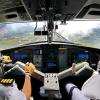Skippers DH8C at Laverton on May 17th 2012, continued steep approach despite EGPWS alert
A Skippers Aviation de Havilland Dash 8-300, registration VH-XFZ performing a charter flight from Perth,WA to Laverton,WA (Australia) with 36 passengers and 4 crew, was on a visual circling approach to Laverton's runway 07, when the EGPWS issued a number of alerts including a "PULL UP" alert at 400 feet AGL. The aircraft descended through 300 feet AGL, the operator's gate to verify the approach was stabilized, at a rate of descent above 1800 feet per minute and 11 knots above Vapp, the crew however continued the approach for an ultimately safe landing on Laverton's runway 07.
Australia's Transportation Safety Board (ATSB) released their final report stating, that the crew did not report the occurrence. The operator's chief pilot got aware of the occurrence a week later and immediately notified the ATSB.
The ATSB concluded the factors probably causing the incident were:
Contributing factors
- While manoeuvring to avoid cloud during a visual circling approach, the flight crew positioned the aircraft on final approach with an excessive rate of descent of 1,800 ft/min when passing the 300 ft minimum stabilisation height, and then continued the approach rather than going around as required in the case of an unstable approach.
- At a time when the flight crew were focussed on descending through a break in the cloud and the first officer was relying on the captain to call deviations from stable flight, the captain did not monitor the aircraft’s rate of descent, resulting in degraded situation awareness.
- The flight crew did not execute a go-around following an enhanced ground proximity warning system ‘pull up’ warning alert at 400 ft on final approach due to an inadequate understanding of the applicable standard operating procedure.
Other factors that increase risk
- During the visual circling approach, the flight crew did not respond effectively to the cautions and warnings from the enhanced ground proximity warning system.
- At the time of the occurrence, simulator training was not provided to enable crews to recognise and respond correctly and rapidly to cautions and warnings from the enhanced ground proximity warning system.
Other findings
- The minimum stabilisation height of 300 ft in visual meteorological conditions as stipulated in the operations manual was lower than the 500 ft recommended by the International Civil Aviation Organization.
- At the time of the occurrence, the weather conditions at Laverton were consistent with the forecast and the crew had planned the flight accordingly.
- The crew did not report the warning alert from the enhanced ground proximity warning system to the operator, delaying notification to the Australian Transport Safety Bureau.
The ATSB reported the first officer (2,070 hours total, 685 hours on type) was pilot flying, the captain (5,000 hours total, 2,700 hours on type) was pilot monitoring for the sector to Laverton.
The flight had departed Perth in the knowledge that fog and low level cloud were forecast for Laverton. While descending towards Laverton the crew observed the weather was mostly clear, however bands of fog and low level stratus cloud were present in the general vicinity of the aerodrome. The wind favoured a straight in approach to runway 07, the crew therefore chose to perform a GPS based approach procedure for a straight in runway 07. The crew configured the aircraft for landing and joined final, when at MDA at 690 feet AGL the crew became visual with the runway however with cloud below them. The crew therefore decided to join the upwind visual circuit for a right hand traffic pattern at above 1000 feet AGL. In order to maintain visual contact the first officer turned the aircraft from downwind onto base leg early, about 10-15 seconds after passing abeam the threshold of runway 07, the base leg flown as a continuous turn onto final, the aircraft nonetheless crossed the runway centerline requiring the first officer to continue the right hand turn to intercept the extended centerline by a left turn. Both pilots spotted a gap in the cloud through which the runway remained visible, they both agreed to continue the approach through that gap although it required a steep descent.
The aircraft descended through 900 feet AGL banked at 25 degrees to the right and at 1400 feet per minute rate of descent, the first officer was focussed on the runway, did not assess the rate of descent excessive and relied upon the captain to call out if any paramters weren't within the target window. The captain however, due to the excessive rate of descent and proximity to ground, was also monitoring the outside and did not watch the instruments other than required by the operations manual, hence the call that the rate of descent exceeded 1000 fpm did not occur although required.
Both crew later recalled that they were high on the approach but believed they would make it down to the normal profile and the approach was stabilizing.
The ATSB reported that when the EGPWS alerts occurred, "the first officer stated that he believed the alerts were spurious but added that his exposure to EGPWS alerts was very limited. The captain stated that in response to the first of the EGPWS alerts he instructed the first officer to reduce the rate of descent and also because he believed the aircraft was nearing the correct approach profile. At the subsequent alert the captain noted that the vertical speed indicator was trending to a lesser rate of descent, and the approach aspect was normalising. He was confident in the first officer’s aircraft handling abilities and did not feel that he had to instruct the first officer to discontinue the approach."
The first EGPWS alerts had been "Sink Rate" warnings.
Subsequently, when the aircraft descended through 730 feet AGL, the rate of descent had increased to 2500 fpm peaking at that value, at 400 feet AGL an EGPWS alert "PULL UP" occurred, the sink rate reduced to 1800 fpm at 300 feet AGL, at which point the aircraft was banked left at 23 degrees and the airspeed was 11 knots above Vapp. At 100 feet AGL the sink rate had further reduced to 1200 fpm, the landing flare commenced and a normal touch down followed.
The ATSB analysed that the crew was unaware that a valid EGPWS warning required a go-around even in VMC and therefore continued the approach. The ATSB stated: "If the crew had responded to the warning with a scan of the instruments they would have realised that the descent rate of about 2,100 ft/min at the time was excessive for the height above terrain and the warning was valid. By not responding effectively to the EGPWS cautions and warnings, the crew increased the risk of an approach or landing accident."
The ATSB continued: "The EGPWS warning should also have given the flight crew a strong indication that the approach was not stable. However, they continued with the approach despite not being able to satisfy the stabilised approach criteria at the height specified the operator’s standard operating procedures."
Flight path (Graphics: ATSB):
http://avherald.com/h?article=46c9332a














Komentarze